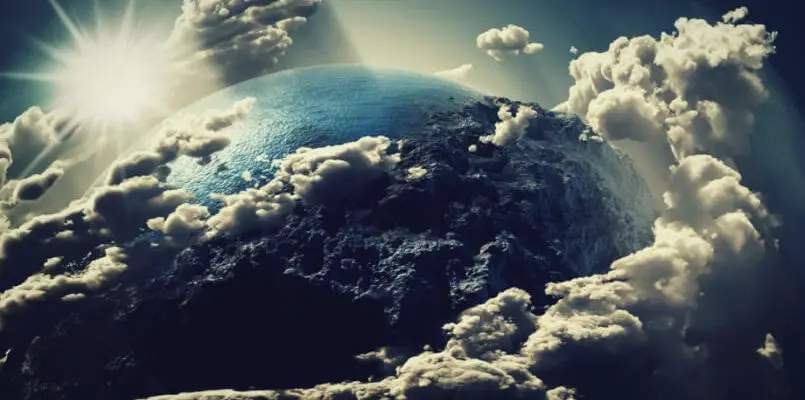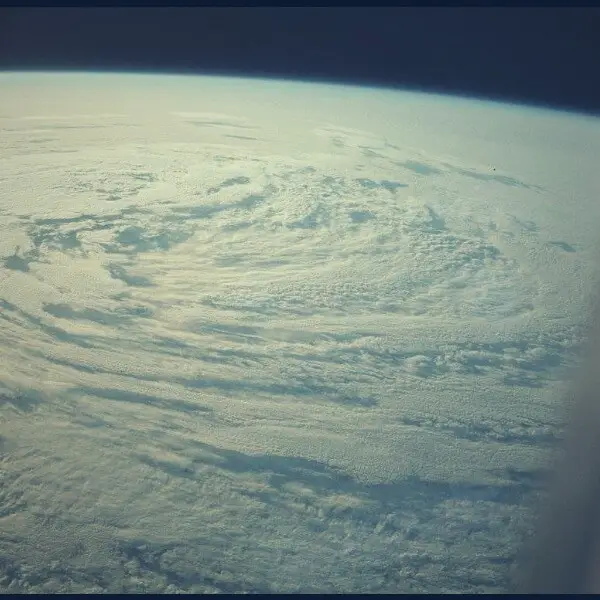What is the atmosphere like? What is the structure and composition of the Earth’s atmosphere? What layers does it consist of? What are the limits of the Earth’s atmosphere? What are the most exciting facts about the atmosphere?

If these questions torment your mind, you will find out the answers to them right now! In this article, we will analyze in detail everything related to the atmosphere, learn about its layers, chemical composition, physical properties, and much more. You are ready?
77 interesting facts about the atmosphere
In order to make it easier for you to read and absorb the material, we have divided all the facts about the atmosphere into groups.
What is the Atmosphere?
1. The atmosphere is the layers of gas that surround a celestial object. An object can have an atmosphere if there is sufficient gravity.
2. The atmosphere of the stars is called the stellar atmosphere. It sits above the photosphere (the shell of a star that emits light).
3. Stars with relatively low temperatures can have an atmosphere with compound molecules.
4. The composition of the atmosphere of each celestial body is different. The atmosphere gradually changes as the climate and weather change.
Composition of the Earth’s atmosphere
5. The Earth’s atmosphere is a mixture of several gases. The main gases are nitrogen and oxygen, which make up 99% of the atmosphere.

6 . The amount of water vapor (H2O) present in the Earth’s atmosphere depends on location.
7 . The atmosphere contains many trace elements: argon, methane, carbon dioxide, nitrous oxide, ozone, etc. Trace elements (except argon), along with water vapor, are greenhouse gases.
8. Greenhouse gases are gases that trap heat and help maintain the Earth’s temperature (greenhouse effect).
9. Contrary to popular belief, the greenhouse effect is essential for our planet.
10. However, if the percentage of greenhouse gases in the atmosphere increases, this leads to the so-called enhanced or anthropogenic greenhouse effect.
11. The enhanced greenhouse effect heats the planet’s surface, resulting in global warming and climate change.
12 . The percentage of gases present in the Earth’s atmosphere is given below:
The content of gases in the earth’s atmosphere
| Gas name | % in the atmosphere | % contribution to the greenhouse effect |
| Nitrogen (N2) | 78.1% | – |
| Oxygen (O2) | 20.9% | – |
| Argon (Ar) | 0.9% | – |
| Carbon dioxide (CO2) | 0.03% | from 9% to 26% |
| Neon (Ne) | 0.0018% | – |
| Helium (He) | 0.0005% | – |
| Methane (CH4) | 0.000179% | from 4% to 9% |
| Water vapor (H2O) | from 0.001% to 5% | from 36% to 70% |
| Hydrogen (H2) | 0.01% | – |
| Ozone (O3) | 0.00006% | from 3% to 7% |
13. Ozone absorbs the ultraviolet rays that the sun emits.
14. If there was no ozone, there would be no life on Earth.
15. Water vapor is the source of all types of precipitation. Its share decreases with increasing height.
16. Dust particles (sand, ocean salt, ash, pollen, and smoke) are also present in the Earth’s atmosphere, but in minor amounts.
17. Dust participates in the condensation of water vapor, in turn, helping the formation of clouds.
Layers of the atmosphere
Now that we know the composition of the Earth’s atmosphere, it’s time to learn about its various layers.
18. The Earth’s atmosphere extends approximately 1,600 kilometers in height. However, 97% of the mass of the atmosphere is concentrated in the first 30 kilometers.
Amazing, and Interesting Atmosphere facts
“Just being alive, watching the sun rise over the glittering snowy hills, is the greatest treasure on earth.”
J.K. Rowling, Harry Potter and the Deathly Hallows
19. There are five layers of the atmosphere. This division is based on temperature and density differences.
20. 5 layers of the atmosphere are the troposphere, stratosphere, mesosphere, thermosphere, and exosphere.
Troposphere – the first layer of the atmosphere
21. Troposphere is the lowest layer. It extends up to 18 kilometers at the equator and up to 8 kilometers at the poles. The average height is about 12 kilometers.
22. The reason for the higher altitude near the equator is the presence of hot convection air currents that push gases upward.
23. The temperature and density of the troposphere decrease when moving upward. This means that the lower troposphere is the warmest and densest.
24. Temperature in the troposphere decreases by 1 ° C for every 165 meters of altitude.
25. By mass, the troposphere is 80% of the Earth’s atmosphere. 50% of the mass of the atmosphere is present in the first 5.6 kilometers of the troposphere.
26. Most of the water vapor is in the troposphere, so almost all weather-related phenomena occur in it.

27. The air in the troposphere is constantly moving (“tropo” – in Greek means “turn”).
28. The transition zone between the troposphere and the stratosphere is called tropopause.
29. The tropopause has the characteristics of both the troposphere and the stratosphere. In it, the temperature drops to minus 80 ° C.
Stratosphere – the second layer of the atmosphere
30. The stratosphere starts at 12 kilometers from the Earth’s surface and ends at 50. Its average height is 40 kilometers.
31. The temperature in the first 20 kilometers of the stratosphere remains practically unchanged. For the next 20 kilometers, the temperature rises.
32. The rise in temperature is due to the ozone layer in the stratosphere.
33. Since the stratosphere is practically free of weather and clouds, it is ideal for aviation.
34. The pressure in Stratopause (the transition zone between the stratosphere and the mesosphere) is 1000 times less than the pressure at sea level.
35. The temperature in the stratopause is approximately 0 ° C.
Mesosphere – the third layer of the atmosphere
36. The mesosphere extends up to 80 kilometers in height from the surface of the Earth. It itself has a height of 30 kilometers.
37. Temperature decreases with increasing altitude. The temperature in the mesopause (the transition zone between the mesosphere and the ionosphere) is about minus 85 ° C. This zone is the coldest place on Earth (given the atmosphere).
38. The air under the mesopause is rather cold, and, despite the presence of a small amount of water vapor, it condenses and forms silvery and luminous clouds.
39. These clouds are the highest in the Earth’s atmosphere. They can only be seen during dusk or dawn.
40. All meteors burn out in the mesosphere.
Thermosphere – the fourth layer of the atmosphere
41. The thermosphere begins at a height of 80 kilometers above the Earth’s surface. Its length ranges from 420 to 880 kilometers.
42. The temperature in the thermosphere increases with increasing altitude. It can rise up to 1500 ° C.
Amazing, and Interesting Atmosphere facts
“The immense depth and boundlessness of the sky can be judged only at sea and in the steppe at night when the moon is shining.”
A.P. Chekhov, “Steppe”
43. However, a person will not be able to feel such a high temperature, since the air density is very low.
44. The Northern Lights are formed in this layer of this atmosphere.
45. The ISS, which orbits the Earth, is in this layer. It revolves around the Earth at an altitude of 350 to 420 kilometers.
46. Due to changes in solar activity, the height of the thermopause (transition zone between the thermosphere and exosphere) varies.
47. The lowest part of the thermosphere (80 to 550 kilometers) is called the ionosphere.
48. The ionosphere contains electrically charged ions, hence the name – the ionosphere.
Exosphere – the fifth layer of the atmosphere
49. The last or upper layer of the atmosphere is the exosphere. It starts at an altitude of 700 kilometers above sea level.
50. The exosphere extends across the bottom of 10,000 kilometers and eventually mixes with the solar wind (a stream of charged particles emitted by the sun).
51. Oxygen and nitrogen are present in the thermal pause, while hydrogen and helium are present in the upper part of the exosphere.
52. Gas molecules in the exosphere are so far apart that they can move without collisions and fly into space. The absence of gravity makes the air density in this layer minimal.
Layers of the Earth’s atmosphere in order, the temperature in them, and their height
| Atmosphere layer | Temperature | Height, km |
| Troposphere | falls with increasing height | 0 – 12 |
| Stratosphere | grows with height | 12 – 50 |
| Mesosphere | falls with increasing height | 50 – 80 |
| Thermosphere | grows with height | 80 – 700 |
| Exosphere | remains constant | 700 – 10000 |
Other layers of the earth’s atmosphere
Based on other physical properties, the Earth’s atmosphere can be divided into several more layers.
53. The planetary boundary layer is part of the troposphere. The height of the planetary boundary layer ranges from 100 to 3000 meters.
54. The ozone layer is the layer where the concentration of gaseous ozone is highest. It is located at an altitude of 15 to 35 kilometers, but its thickness depends on the season and geographic location. The stratosphere contains 90% of the ozone of the entire atmosphere.
55. The ionosphere is an area that is ionized by solar radiation. During the daytime, the ionosphere includes the mesosphere, thermosphere, and part of the exosphere. At night – only the exosphere and thermosphere. This is the layer of the atmosphere that is responsible for the aurora.
56. The ionosphere forms the inner boundary of the magnetosphere (the area surrounding the Earth, where charged ions or particles are affected by its magnetic field).
57. The homosphere is characterized by the mixing of atmospheric gases. The troposphere, stratosphere, mesosphere, and lower part of the thermosphere make up the homosphere. It extends up to 100 kilometers (known as the Karman Line) from the Earth’s surface.
58. Heterosphere is an area where gases are separated under the influence of gravity. The lower part of the heterosphere consists of oxygen, nitrogen, and the upper part contains mainly hydrogen.
Evolution of the atmosphere
59. At the beginning of our planet’s existence, the atmosphere was dominated by such gases as hydrogen, water vapor, ammonia, and methane.
60. The atmosphere has changed due to volcanism and bombardment by huge asteroids and meteorites.
61. The end result of these two phenomena was an atmosphere dominated by nitrogen, carbon dioxide, and noble gases.
62. Such an atmosphere is called reducing because there was no oxygen in it.
63. About 280 million years ago, the atmosphere was about the same as it is today. The oxygen percentage was 30% compared to 21% present.
64. The atmosphere is changing due to two phenomena – volcanism, in which sulfur and carbon dioxide are released, and photosynthesis, in which oxygen is released and carbon dioxide is absorbed.
Physical properties of the earth’s atmosphere
Consider the facts about the atmosphere in the context of physics.
65. Atmospheric pressure is 101325 Pa or 760 mm Hg. However, it is not uniform.
66. 50% of atmospheric pressure is observed in the first 5-6 kilometers of altitude. 99.99% of the pressure is on the first 100 kilometers. Anyone who crosses this altitude is considered an astronaut.

67. The speed of sound depends on the temperature of the atmosphere and does not depend on its density or pressure.
68. The density of air at sea level is about 1.2 kg / m3. The density of the atmosphere decreases with increasing altitude.
69. The mass of the atmosphere is about 1/1 200 000 of the mass of the entire planet, which is 5 quadrillion tons.
Fun facts about the atmosphere
70. Oxygen is extremely important for living organisms, but did you know that it was the oxygen that caused the first mass extinction of living things on Earth?
71. At that time, living organisms were anaerobic (that is, they did not need oxygen to survive). Excess oxygen was toxic to them. When there was too much oxygen, these organisms died out.
72. The color of the sky is actually purple. We see blue skies due to a phenomenon called Rayleigh scattering.
73. Blood or any other body fluid will boil at an altitude of 18,000 meters. At this altitude (Armstrong limit), the pressure and boiling point drop sharply.
74. The atmosphere contains 200 trillion liters of water.
73. White streaks from airplanes are formed because the engine emits hot and humid water vapor that meets the cold air. The water vapor freezes and becomes visible. This also happens when you breathe out air through your mouth in cold weather.
74. Airplane stripes can indicate weather. If they are weak, the humidity is less and the day will be sunny, but if the tracks are thicker, rain can be expected.
75. Ozone is formed when oxygen atoms are exposed to ultraviolet radiation. And it … prevents the penetration of ultraviolet radiation to the Earth.
76. Acid rain is formed when sulfur dioxide or nitric oxide reacts with steam to form sulfuric acid or nitric acid. Acid rain can destroy everything – both living and non-living.
77. Sulfur dioxide is formed as a result of volcanic eruptions, and nitric oxide – during lightning.
Read Also:

